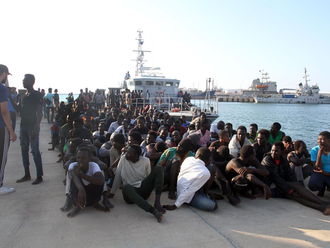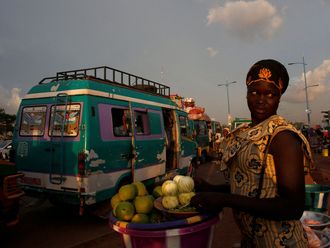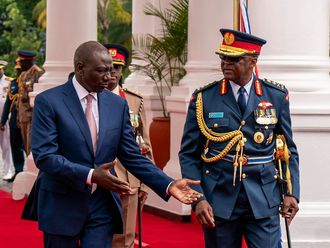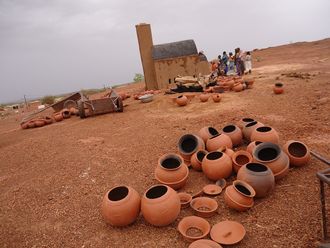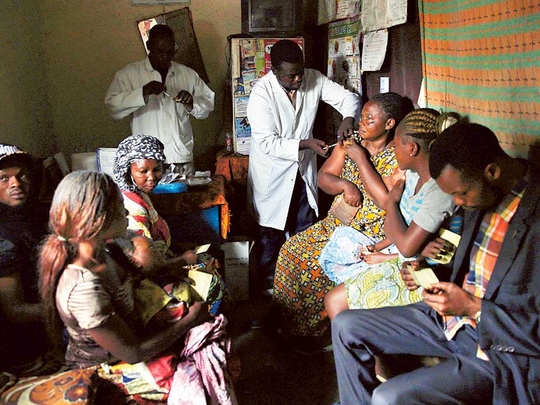
KINSHASA, Congo
The World Health Organisation and its partners shipped more than 6 million yellow fever vaccines to Angola in February to quash an emerging epidemic, yet when they asked country officials the following month what happened to the vaccines, they discovered that about 1 million doses had mysteriously disappeared.
Of the shipments that did make it to Angola, some vaccines were sent to regions with no yellow fever cases, while others arrived at infected areas without syringes. In neighbouring Congo, some vaccines weren’t always kept cold enough to guarantee they would be effective.
Teams from MSF carry out fumigation in Kinshasa, Congo to kill mosquitos that transmit yellow fever. AP
This lack of oversight and mismanagement has undermined control of the outbreak in Central Africa, the worst yellow fever epidemic in decades, an Associated Press investigation has found.
There is now a shortage of vaccines so severe that WHO has recommended doses be diluted by 80 per cent to stretch the supply, even though there is limited evidence they will be effective in African populations.
WHO vowed after its fumbled response to the 2014 Ebola epidemic in West Africa that it would adopt a “no regrets” policy to better manage future disease outbreaks with its partners in other health organisations and national governments. But according to hundreds of pages of internal emails and documents obtained by AP, the UN health agency is facing many of the same problems that compromised its handling of Ebola, an outbreak that killed 11,000 people in three West African countries.
Health officials now estimate they will be short millions of doses to fight an epidemic that has also spread to Congo. To date, yellow fever is estimated to have caused upward of 5,000 cases and at least 450 deaths. More than 18 million vaccines have been sent to the continent, far short of the 40 million doses some experts think are needed to contain the outbreak.
Residents of the Kinshasa receive yellow fever vaccines. Vaccine shortage has hit efforts to rein in the epidemic. AP
Some of the most vulnerable areas of Congo’s sprawling capital have been vaccinated, but millions of people still are waiting for doses as fumigation teams spray crowded neighbourhoods in an attempt to kill the mosquitoes that spread the disease.
Amanda McClelland, a senior emergency official at the International Federation of Red Cross and Red Crescent Societies, or the IFRC, said the crisis is a repeat of WHO’s mismanagement of the Ebola epidemic in 2014.
“It was the same people at WHO that made the initial calls during Ebola and it was the exact same response: We’ve got enough, we don’t need any help and it’s all under control.”
Unlike Ebola, yellow fever is not highly contagious and is easily prevented with vaccines. The virus is transmitted by the Aedes aegypti mosquito, the same species that spreads Zika, dengue, and chikungunya. Once infected, people often fall ill with fever and muscle pain, but many recover after several days. Others, however, suffer a more toxic phase and can develop jaundice, as the virus attacks the liver and kidneys. In the worst cases, patients bleed internally in their digestive systems, becoming delirious before dying. According to WHO, the death rate for reported cases is between 15 to 50 per cent.
Yellow fever has largely been eliminated in developed nations after vaccines were developed in the 1930s, but outbreaks continue in Africa and Latin America. For countries that cannot afford broad vaccination programs, a consortium was formed in 2001 by WHO, the International Federation of the Red Cross and Red Crescent Societies, Doctors Without Borders and UNICEF. Their role is to dole out the global emergency stockpile of about 6 million vaccines, which cost less than $2 (Dh7.35) each. Until this outbreak, the consortium had never before used more than 4 million doses in any one country.
Four companies produce yellow fever vaccine for WHO and its partners, and as the outbreak worsened, officials pressed manufacturers to rush the production of more.
On February 12, WHO announced Angola had a yellow fever outbreak in its capital, and along with its partners, sent more than 6 million doses for a vaccination campaign targeting Luanda, more doses than are usually contained in the emergency stockpile.
Shocking discovery
To verify that the vaccines had reached those who needed them, health officials asked Angola for a detailed accounting of their use.
The answer: 1 million doses had disappeared — “evaporated” — probably taken by “friend(s) and families of the local authorities,” the “army” or resold in the “private sector,” according to a WHO email to its partners.
“How can this happen in a situation of (vaccine) shortage?” asked WHO’s Sergio Yactayo, a Geneva-based yellow fever expert, in a March 4 missive to his colleagues at UNICEF, the IFRC, Doctors Without Borders and WHO.
In a series of internal calls over the summer, health officials complained that shots approved for specific regions with documented yellow fever cases were sometimes used in areas that had no cases — without any explanation — according to sources familiar with the problem who were not authorised to discuss it.
“Vaccine is the only way to control a yellow fever epidemic,” said Dr. Peter Piot, director of the London School of Hygiene and Tropical Medicine. “This is where WHO should insist on accountability ... they have to know how the vaccine is being used to know they are making the right decisions.” WHO’s Aylward said tracing the vaccines’ usage is an “incredibly important issue”.
As yellow fever tore through Angola and Congo, UN officials made a series of other mistakes that stalled control efforts.
Ahead of a key vaccination campaign, WHO’s country representative in Angola learnt that vaccines had been shipped — but without any of the material needed to use them, including syringes.
In Congo, aid workers faced another problem: how to prevent the vaccines from spoiling in the heat.
On July 8, an internal memo to WHO’s Director-General Dr. Margaret Chan relayed more disturbing news: the sole laboratory in Kinshasa responsible for testing all yellow fever cases in Congo had halted operations two weeks earlier. The lab was awaiting more diagnostic materials. Confronted with an urgent demand for a limited supply of vaccines, WHO and partners are now turning to a largely untested theory to stretch the number of shots: fractional dosing, or using one fifth of the standard dose so that five people can be treated instead of just one.
— AP


